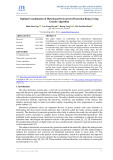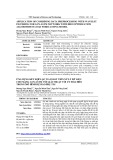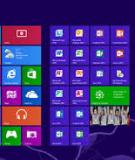
http://www.iaeme.com/IJMET/index.asp 952 editor@iaeme.com
International Journal of Mechanical Engineering and Technology (IJMET)
Volume 10, Issue 03, March 2019, pp. 952–963, Article ID: IJMET_10_03_096
Available online at http://www.iaeme.com/ijmet/issues.asp?JType=IJMET&VType=10&IType=3
ISSN Print: 0976-6340 and ISSN Online: 0976-6359
© IAEME Publication Scopus Indexed
ANALYSIS OF NETWORK PERFORMANCE
MANAGEMENT DASHBOARD
Desi Mega Paramita and Ahmad Nurul Fajar
Information Systems Management Department, BINUS Graduate Program-Master of
Information Systems Management, Bina Nusantara University Jakarta, Indonesia
ABSTRACT
Analysis of performance availability is very important to help improve network
performance. This is due to developing services to be used by customers. In performance
availability it is known that there are many problems that occur in each event in the
field. In achieving the optimal level in carrying out the implementation and support
processes of the performance management dashboard, an analysis is needed to develop
management and control in the networking division with the aim of generating
utilization in the implementation and support processes to align with the business needs
of PT ABC. The existing reference model is a reference model that refers to the
functional area of FCAPS. The FCAPS model consists of five functional areas,
including fault management, configuration management, accounting management,
performance management, and security management. In general, companies have
implemented FCAPS on failure issues and configurations (fault and configuration).
Security / security has relied on other tools that are not integrated in the FCAPS model
as a whole. The basic principle is, even though there are five elements from FCAPS,
one element can influence the success of other elements.
Key words: Performance, FCAPS, Network.
Cite this Article: Desi Mega Paramita and Ahmad Nurul Fajar, Biomass-Based
Analysis of Network Performance Management Dashboard, International Journal of
Mechanical Engineering and Technology 10(3), 2019, pp. 952–963.
http://www.iaeme.com/IJMET/issues.asp?JType=IJMET&VType=10&IType=3
1. INTRODUCTION
Current developments make technology develop rapidly. Telecommunications signals are not
always good. But often many problems occur in the networking section. Problems that occur in
the networking section include power, transmission, theft, BTS hardware and BTS software.
BTS (Base Transceiver Station) has the function of a radio interface between mobile phones
and cellular telecommunications networks. Technology in telecommunications has evolved
from 1G to 4G or commonly referred to as LTE. The development of this technology indirectly
presses mobile phone operators and operator users to keep up with the technological progress.
PT. ABC stands as the first telecommunications company with foreign investment (PMA)
in Indonesia, which provides telecommunications services both nationally and internationally

Desi Mega Paramita and Ahmad Nurul Fajar
http://www.iaeme.com/IJMET/index.asp 953 editor@iaeme.com
through international satellite. PT ABC developed as the first international telecommunications
company bought and owned by the Indonesian government 100%. Analysis of performance
availability is very important to help improve network performance. This is due to developing
services to be used by customers. In performance availability it is known that there are many
problems that occur in each event in the field. Communication system in GSM (Global System
for Mobile), BTS is the main point of the cells at each site. BTS is a transmitter and receiver
that directly handles the access of the transmission route that is connected to the mobile station
via the air interface. Therefore, BTS needs to maintain and replace the device if it is past the
date of use in order to avoid interconnected device problems. Analysis is also needed to monitor
the BTS system in order to maximize BTS performance. On the monitoring Dashboard that has
been made can help carry out the procurement of goods, facilitate the decision-making system.
From the system, decision-making for management results in root causes that occur for
management.
Figure 1. Trendline network performance management dashboard
In order for PT ABC to achieve an optimal level in carrying out the implementation and
support processes of the performance management dashboard, an analysis is needed to develop
management and control in the networking division with the aim of generating utilization in the
implementation and support processes to align with existing business needs.
One framework that can be used to carry out an analysis is ISO (International Standard
Organization). ISO has a large contribution in terms of network standardization. ISO has a
standard network management model that fulfills its five main functions, namely Fault,
Configuration, Accounting, Performance, Security, which is usually abbreviated as FCAPS
which should be owned by the Network Management System. Performance management also
measures network performance aspects such as network throughput, user response time, and
channel usage so that network work can be adjusted to acceptable levels.
2. LITERATURE REVIEW

Analysis of Network Performance Management Dashboard
http://www.iaeme.com/IJMET/index.asp 954 editor@iaeme.com
2.1. ISO Network Management Processes
Network management methodology that brings together network maintenance activities. The
network management model of the International Organization for Standardization (ISO) defines
five functional areas of network management. This document covers all functional fields. The
overall aim of this document is to provide practical recommendations in each functional area to
improve the overall effectiveness of current management tools and practices. It also provides
design guidelines for implementing network management tools and technologies in the future.
FCAPS: namely the International Organization for Standardization (ISO) TMN model and
framework for network management. The FCAPS model, was inaugurated at the international
telecommunications union in 1977, which has served for almost a decade to summarize and
simplify the main concepts of Infrastructure Network Management arrangements. FCAPS
includes Fault Management, Configuration Management, Accounting Management,
Performance Management, Security Management.
Figure 2. Interaction of the FCAPS functions (Cisco, 2007)
2.2. Fault Management
Fault Management is a life cycle that focuses on identifying problems through continuous
monitoring of the entire network, correlating fault data and isolating problems to the source.
The function of fault management is to provide facilities that allow network administrators
to find faults on managed devices, networks, and network operations, so that they can
immediately determine the cause and can immediately take corrective action. Fault
Management has a mechanism for reporting errors, recording error reports, making diagnoses,
and correcting errors (made possible automatically).
2.3. Configuration Management
Configuration management includes actual management of configuration management, the
configuration change control process, which is included for commissioning and
decommissioning network devices, configuring backup and restore, and overall workflow
management for tracking and recording changes in configurable devices. The configuration
management function monitors network configuration information so that the impact of certain
hardware or software can be managed properly. This can be done with the ability to initialize,
reconfigure, operate, and turn off the managed device.

Desi Mega Paramita and Ahmad Nurul Fajar
http://www.iaeme.com/IJMET/index.asp 955 editor@iaeme.com
The more network devices used, it is very important to be able to accurately identify the
location of network devices. This location information must provide a detailed description
which means they are assigned to send resources when network problems occur. To speed up
resolution if network problems occur, make sure to have available contact information from the
person or department in charge of the device.
2.4. Accounting Management
Accounting Management includes methods for tracking using statistics and costs associated
with time and services provided with other network devices and sources. Accounting
information for example, such as the utilization and use of device resources used to achieve the
objectives requested from the Service Level Aggrement requested by ensuring that this has been
agreed upon, can be provided. The function of accounting management is to measure network
utilization of certain users or groups to produce billing information (billing), manage users or
groups, and help maintain network performance at a certain acceptable level.
Network accounting management also tracks and records the utilization of network
resources, so that the cost of each user, department, or business unit can be identified. This
management can also use the administration approach, namely to manage user access rights,
authority, synchronization and operations.
2.5. Performance Management
Performance Management includes tracking systems and network statistics using the Network
Management System (NMS). Data collected includes link utilization, errors, response times and
availability information. The data can be used to improve performance for critical traffic, such
as Voice over IP (VoIP), for example by implementing or adjusting Quality of Service (QoS),
which is the solution to making efficient use for users who use limited bandwidth. In addition,
it can also be used to monitor performance management which can be used to establish
thresholds and identify network trends, all of which provide values for data for prolonged
planning. The function of performance management is measuring various aspects of network
performance including the collection and analysis of system statistical data so that it can be
managed and maintained at a certain acceptable level. For this reason, performance
management has the ability to obtain utilization and error rates from network devices, and
maintain performance at a certain level by ensuring the device has sufficient capacity.
Service Level Agreement (SLA) is a written agreement between service providers and their
customers on the expected level of network service performance. SLA consists of metrics
agreed upon between the provider and the customer. The values set for metrics must be realistic,
meaningful, and measurable for both parties. Various interface statistics can be collected from
network devices to measure performance levels. This statistic can be included as a metric in the
SLA. Statistics such as drops in the input queue, output queue drops, and neglected packages
are useful for diagnosing performance related problems.
2.6. Security Management
Security Management handles access rights including authentication and authorization, data
privacy and auditing security violations. From the perspective of network administration,
security management is related to controlling access using network devices. For example in
AAA security devices (Authentication Authorization and Accounting). Security management
includes interating firewalls and other security devices such as the Intrusion Prevention System
(IPS) in the network to protect devices from viruses, worms and malicious types of traffic. The
function of security management is to regulate access to network resources so that information

Analysis of Network Performance Management Dashboard
http://www.iaeme.com/IJMET/index.asp 956 editor@iaeme.com
cannot be obtained without permission. This is done by limiting access to network resources,
and giving notice of attempted violations and security violations.
2.7. Previous Research
In 2014, research on network performance analysis by knowing the factors that influence the
BTS network and knowing how much fuel costs, maintenance and expenses are spent on the
use of power systems using the field observation method.
Other research on the application of the need for Quality of Service (QoS) which has an
influence on the development between public bureau network operators and the internet
community which has a focus on in-service methods and statistical models for monitoring and
estimating short-term parameters in the cell loss process.
Other research on the application of contributions to the role of networks in health care
companies which measures performance and management of public services and network
research in public administration and public management and serves as a strong theoretical
basis for empirical research.
Other research on applies Business Intelligence that is able to be applied to the monitoring
dashboards of student and graduate performance which is made using the Scrum method as a
function for student and graduate competency management.
In 2011, research on the identification of grid application networks and grid technology
which contributes solicitation to awareness scheduling networks. And mengatasisol now now,
the forms of problems needed to create efficient networks, and serve and consider aspects that
meet the requirements.
In 2008, research on the application of large corporate networks to provide capacity and
performance management by who use the NECTEC system which shows that the NMM OSI
substantially meets the requirements of the network management system.
3. METHODOLOGY
The company PT ABC is a telecommunications company that provides telecommunications
services and networks in Indonesia.
In general, the research methodology used in writing this research is as follows:
1. Formulate research problems based on the reality faced by the PT ABC
2. Conduct a literature study by gathering and reading various supporting documents, theories,
and guidelines for frameworks commonly used in IT governance.
3. Placing a problem that is in accordance with FCAPS, taking data and evaluating the process
chosen.
4. Conduct an analysis of the data obtained.
5. Measuring network management in accordance with the FCAPS framework.
6. Conduct report writing, make conclusions and recommendations (suggestions).
3.1. Mind Map


























